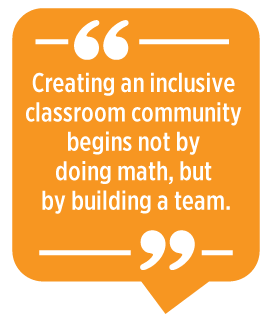|

Talking and using language is essential to the learning
process, but English learners (ELs) in mainstream classrooms tend to talk and
participate less than their peers (Zhang et al., 2016). Although there are
myriad activities, strategies, and modifications available to teachers, they are
often used to supplement “regular” teaching. This article takes a different
approach and offers mainstream teachers a way of considering ELs from the
outset and systematically structuring classroom communication in ways that
promote classroom talk for all students, including ELs.
Together, we
describe the process Mr. Paulsen, a former high school mathematics teacher,
used to create this type of classroom and provide insights into why these
structures work for ELs. Mr. Paulsen notes that nothing he does is necessarily
new or original, but his combination of pedagogical actions can provide
guidance to other teachers looking to create EL-engaging classrooms of their
own.
Start Early
Build a Team
Creating an
inclusive classroom community begins not by doing math, but by building a team.
The first week of Mr. Paulsen’s class was dedicated to establishing a classroom
culture in which everyone was recognized as a valuable member and was expected
to participate fully and contribute to the team. First-week team building
activities, such as the
human knot, no-hands
cup stacking challenge, helium
sticks, and nonverbal
birthday organization, allowed students to learn about each other,
open lines of communication, and practice working with every student in the
class, not only established friends or fellow ELs. These often humorous
activities allowed students to build rapport and trust and, through the
numerous attempts required for many of the activities, also gave students
repeated opportunities to fail, work as a team, think divergently, and try
different approaches until the goal was achieved.
 Normalize
Mistakes Normalize
Mistakes
Mr. Paulsen
reinforced this concept of “failing forward” later in the first week by
explaining emotional intelligence and the importance of a growth mindset
(Dweck, 2008). For adolescents with still-forming prefrontal cortexes,
understanding their own feelings allows them to better understand their
learning process, including the importance of making mistakes, persevering, and
trying again. To emphasize that “mistakes are expected, respected, and
inspected,” Mr. Paulsen showed a soccer highlight reel of Lionel Messi’s
greatest goals scored, followed by a video of Messi at practice, taking kicks
over and over, often missing the target, sometimes frustrated, but always
making adjustments and trying again.
Because many
ELs experience language-related embarrassment, anxiety, and fear of making
mistakes that can impede their willingness to communicate (Pappamihiel, 2002),
repositioning mistakes as part of successful learning works to remove some of
these emotions and barriers to participation. Furthermore, any negative or
teasing comments about mistakes—either linguistic or mathematical—were
immediately addressed as essential to the learning process and positively
reframed as opportunities to “grow your brain.”
Develop
Communication Structures
Beyond
conveying that imperfect communication is still important communication, Mr.
Paulsen also taught many norms and routines to help facilitate classroom talk.
These included voice volume expectations (where Level 0 is silence, Level 1 is
for small group talk, and Level 2 is public-speaking volume which the entire
class can hear) and bring-backs—call-and-response techniques, such as “clap
once if you can hear me,” for transitioning students back to whole class
activities.
Mr. Paulsen
also taught students how to interact with one another in small groups and
engage in standards-based mathematical skills, such as explaining individual
and group thought processes, asking questions to other students, creating
viable arguments, and critiquing the reasoning of others. Within small groups,
each student was assigned roles, such as the reader who reads or repeats the
problem, the rephraser who rewords the problem, and the moderator who ensures
that everyone has an opportunity to speak. These roles served to distribute
conversational responsibility across all students as well as to “translate”'
mathematical language into what Mr. Paulsen often refers to as “kid-friendly
language.”
Combined,
these routines enable all students to engage in academic talk and to quickly
and seamlessly transition between activities. This collective learning
reinforced that everyone is learning something new and together establishing a
new status quo. In this way, ELs were not positioned as outsiders who were
unfamiliar with the language and culture of the class, but as fellow insiders
and knowers who understood the local language and customs.
Reinforce Culture Every Day
After
learning teamwork and communication norms, Mr. Paulsen then applied these ideas
to his mathematics classroom on a daily basis. Unlike many activities and
strategies that are used in isolated lessons, these routines are deeply
embedded in the classroom culture. They are used every day, several times a
day, and give structure to student interactions and participation.
Leverage Talk and
Silence
Mr. Paulsen
generally organized his class using a “back and forth” style wherein students spent
the majority of time working in small groups, he would frequently bring them
back together as a whole class, then release them back to their groups. This
modified think-pair-share interaction is often initiated by Mr. Paulsen asking
a question, then saying, “just think silently for 10 seconds, silent Level 0.
[10-second pause] Okay, go.” This silence gives students a few seconds for both
understanding and preparing to produce language before being asked to speak to
their group, rather than having English-fluent students contribute quickly
while ELs are still interpreting the question.

Value Divergent
Ideas
Whereas some
teachers bring the class back together and either “cold call” on students or
ask for volunteers to give an immediate response, Mr. Paulsen would “warm call”
on students. Before bringing the class back together as a group, he would
inform a few students, including ELs, that he would call on them to present and
explain their answer to the group. Students then use the last minute of group
work to double check answers and practice language with their group before
being asked to speak in front of the whole class. Mr. Paulsen then used a
bring-back to transition the class back together and call on the two or three
students he warmed-called, ignoring any hands to volunteer or shout out
answers. He strategically warm-calls multiple students from groups that solved
or approached the problem differently, debated processes, or had interesting
explanations, including groups with both correct and incorrect answers. This
approach echoes the didactic value of mistakes, the diversity of mathematical
expression, and that every student contributes mathematical
knowledge.
Preserve EL
Voices
Using
philosophies to “never say anything a kid can say” (Reinhart, 2000) and
rejecting perceptions that teachers are the gatekeepers of knowledge, Mr.
Paulsen rarely confirmed right answers or restated what students said. In
small-groups, many raised hands asking for help were answered with “I don’t
know, ask your group,” leaving the task of explaining or confirming right
answers to peers. Similarly, if answers were not heard or understood in
whole-class discussions, students were asked to speak louder, repeat
themselves, or ask a peer for help conveying their thoughts. Importantly, Mr.
Paulsen never summarizes or repeats student answers or recasts EL speech into
“correct” English and focuses instead on the mathematical meaning conveyed,
thus encouraging, validating, and preserving EL voices.
Whole-class
time is space for students to explain concepts and ideas to each other, not
simply for the first student with a raised hand to state the correct answer for
the teacher to confirm and then move on. For ELs specifically, this structure
provides time to interpret questions, direction on mechanics of group talk, and
opportunities to prepare language before being asked to speak in front of the
class.
Conclusion
Though some
may view this routine-based pedagogy as restrictive or authoritarian, these
routines served to empower students by teaching them how to communicate with each other, not what to
say. In this context, these structures did not force participation; instead
they reduced communicative ambiguity by offering clear guidelines so students
knew what to expect and what was expected of them. Furthermore, by
participating in every bring-back routine, carrying out their small group
roles, and explaining ideas to classmates, all students, including ELs, were
habitually recognized and affirmed as knowledgeable members of the classroom community.
By
considering EL needs from the outset, educators can create classrooms where ELs
have the time and space to speak, where their voices are heard, and where they
are never excluded, ignored, or left behind. Implemented alongside other best
practices, this process has successfully been used and adapted with middle and
high school contexts and with ELs at high beginning proficiency levels and
above. We encourage other mainstream teachers in similar contexts to examine
their own classroom communication and consider ways to account for ELs in the
classroom culture, structure, and everyday routines.
References
Dweck, C. S.
(2008). Mindset: The new psychology of success. Random
House.
Pappamihiel,
N. E. (2002). English as a second language students and English language
anxiety: Issues in the mainstream classroom. Research in the Teaching
of English, 36, 327–355.
Reinhart, S.
C. (2000). Never say anything a kid can say! Mathematics Teaching in
the Middle School, 5, 478–483.
Zhang, J. N., Chunling, N., Munwar,
S., Anderson, R. C. (2016). What makes a more proficient discussion group in
English language learners’ classrooms? Influence of teacher talk and student backgrounds. Research in the Teaching of English, 51(2),
183–208.
Meghan Odsliv
Bratkovich is an assistant professor of
Foreign Language and ESOL Education at the University of South Florida. Her
research focuses on teaching English learners in mainstream and content-area
contexts and equipping teachers with the knowledge and skills to do
so.
Andrew
Paulsen is a former high school math
teacher and instruction coach in Newark, New Jersey, USA. He is currently a
senior advisor with Agile Mind, a national organization that transforms the
teaching and learning of mathematics and science, while working to improve
public education as a doctoral student at Vanderbilt
University. |